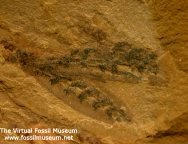|
Phylum
Chordata |
|
From
the first dawn of life, all organic beings are found to resemble each other in
descending degrees, so they can be classed in groups under groups. Charles
Darwin, Origin of Species, Chapter 13 |
 Phylum
Chordata comprises those animals most often occupying the top
of the food chain, including the fishes, reptiles (and thus the
extinct dinosaurs), reptiles, birds and mammals (including humans).
The Chordates primary common feature is a notochord, a rod extending
most of the length of the organism. Lying dorsal to the gut but
ventral to the central nervous system, it stiffens the body and
acts as support during locomotion. More specifically, the notochordat
should be present at least during some part of the organisms development.
Other common morphologies include bilateral symmetry, segmented
body, a well-developed coelom, a single, dorsal, hollow nerve
cord, usually with an enlarged anterior end (i.e., brain), a tail
projecting beyond (posterior to) the anus at some stage of development,
ventral heart, with dorsal and ventral blood vessels and a closed
blood system, a complete digestive system, and usually, a bony
or cartilaginous endoskeleton. Phylum
Chordata comprises those animals most often occupying the top
of the food chain, including the fishes, reptiles (and thus the
extinct dinosaurs), reptiles, birds and mammals (including humans).
The Chordates primary common feature is a notochord, a rod extending
most of the length of the organism. Lying dorsal to the gut but
ventral to the central nervous system, it stiffens the body and
acts as support during locomotion. More specifically, the notochordat
should be present at least during some part of the organisms development.
Other common morphologies include bilateral symmetry, segmented
body, a well-developed coelom, a single, dorsal, hollow nerve
cord, usually with an enlarged anterior end (i.e., brain), a tail
projecting beyond (posterior to) the anus at some stage of development,
ventral heart, with dorsal and ventral blood vessels and a closed
blood system, a complete digestive system, and usually, a bony
or cartilaginous endoskeleton.
Note:
Classification for vertebrates is in a state of change. As
genomes are sequenced
and the phylogeny of genes studied for homology across species, changes are sure
to result, and in turn the implied evolutionary decendency
in the table below. This
table ends at Tetrapoda, with its obvious importance in the tree-of-life and evolution.
Please link to the next table when it is available.
Phylum
Chordata
|
| Subphylum
Urochordata |
Lancelots |
| Subphylum
Cephlachordata |
Tunicates |
Craniata
(skulls) |
Class
Myxini |
Hagfish
(often grouped with jawless fish) |
Subphylum
Vertebrata
(backbones)
|
Superclass
Agnatha (jawless fish) |
Myxini
(hagfish)
Hyperoartia
Petromyzontidae (lampreys)
Pteraspidomorphi
Thelodonti
Anaspida
Cephalaspidomorphi
Galeaspida
Pituriaspida
Osteostraci |
Infraphylum Gnathostomata
(have jaws) |
Class
Placodermi (note 2) |
Armored
fish |
| Class
Chondrichthyes |
Cartilaginous
fish |
| Class
Acanthodii (note 3) |
Spiney
sharks (extinct) |
Superclass
Osteichthyes (note 4) |
Class
Actinopterygii
(note 5 - ray fished fishes) |
Bony
Ray-finned fish |
| Class
Sarcopterygii (lobe-finned fish) |
Order
Actinistia |
Coelacanths |
| Subclass
Dipnoi |
Lungfishes |
| Superclass
Tetrapoda |
Four-legged
Vertebrates |
- Cephalaspidomorphi:
Lamprey is a jawless fish with a toothed, funnel-like
sucking mouth that most species use to bore into other
fishes to suck blood. Lampreys have enormously different
morphology and physiology than other fishes.
 Placodermi
are armored fishes only known from fossils from the Devonian
. Their head and thorax were covered by articulated armoured
plates and the rest of the body was scaled or naked. Placoderms
were the first of the jawed fishes, their jaws having
evolved from the first of their gill arches. Placodermi
are armored fishes only known from fossils from the Devonian
. Their head and thorax were covered by articulated armoured
plates and the rest of the body was scaled or naked. Placoderms
were the first of the jawed fishes, their jaws having
evolved from the first of their gill arches.- Acanthodii:
The Acanthodians make up a class of extinct fishes, having
features of both bony fish ( Osteichthyes) and cartilaginous
fish (Chondrichthyes). They are sometimes called spiny
sharks, appeared in the early Silurian and persisted into
the late Permian. Importantly, they are the earliest known
jawed vertebrates and they had stout, fixed spines supporting
their fins like a shark's dorsal fin.
- Class
Osteichthyes are the bony fish, a paraphyletic group with
land vertebrates, and hence, four-legged vertebrates are
shown in the table above. Most Osteichthyes belong to
the Actinopterygii. The other seven living species are
called lobe-finned fish, and include lungfish and coelacanths.
Some of species of lobe-finned fish have jointed bones.
They are traditionally treated as a class of vertebrates,
with subclasses Actinopterygii and Sarcopterygii, but
newer schemes may divide them into several separate classes.
The vast majority of fishes are bony fish, and therefore
belong to Osteichthyes. Osteichthyes are the most successful
group of vertebrates based on the number of species.
- The
Actinopterygii are the ray-finned fish. They are the largest
group of vertebrates, with over 27,000 species across
fresh water and marine environments.
|
|


